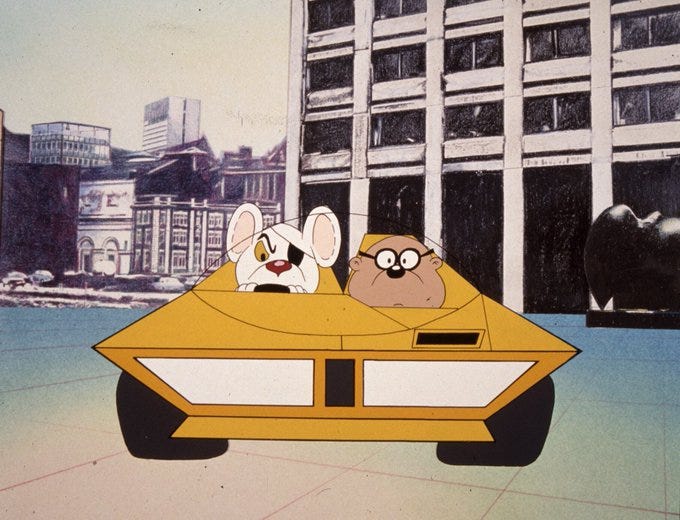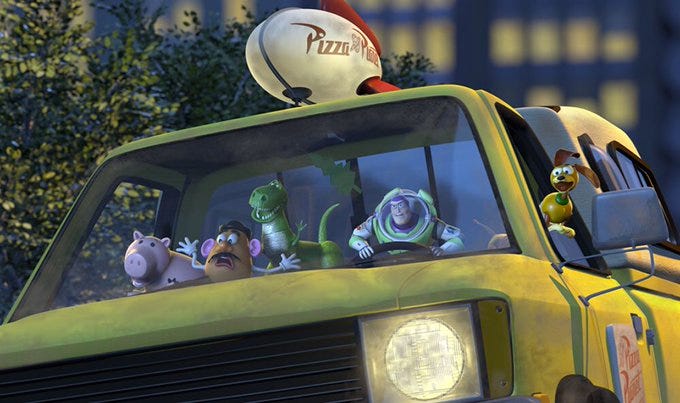Yellow Car
Yellow cars are funny, right?
A few years ago, writing a comedy quiz for the lost-and-much-lamented Craft of Comedy Festival, in Llandudno, I came up with a what-connects round about comedy characters who drove yellow cars.
‘What connects Lance from Detectorists, Tommy Saxondale, Derek Trotter and Dangermouse?’
Lance’s TR7 in Detectorists had jumped off the screen so beautifully as a character note. It seemed to be doing the same job, comedically, as the muscle car in Steve Coogan’s underrated Saxondale, and strangely made me feel the same way as the three-wheeler Reliant Regal in Only Fools and Horses. And then I remembered Danger Mouse, and had a quiz question. But when I asked it I had two reactions from the very comedy literate crowd:
1) What about Taxi? What about the van in The Beiderbecke Affair? Doesn’t Phoebe drive a yellow cab in Friends? There’s a yellow camper van in Little Miss Sunshine, isn’t there? Vyvyan’s flaming Ford Anglia is yellow in The Young Ones, don’t forget! (and so on…)
2) Is this a reference to Cabin Pressure?
On the second count, the answer was ‘no’. At the time, I didn’t know about The Yellow Car Game (‘When you see a yellow car, you must say Yellow Car’) that keeps John Finnemore’s character Arthur Shappey so amused in John’s BBC Radio 4 airborne sitcom. I wasn’t even aware of the more violent traditional variation of the Yellow Car Game that my own kid would introduce me to later, by punching me hard in the arm when a yellow car appeared. (More on that in the another Substack post, I think… There are many interesting Yellow Car Game thoughts to share…)
But the first reaction fascinated me, because it seemed that the yellow car was, without anyone ever stating it as a rule, the default option for comedy.
It’s remarkable because, according to 2022 figures, statistically, only 0.7% of cars are yellow. (Not my words, mind, the words of Top Gear Magazine.) It’s not a car colour we see much outside of Lego and Hot Wheels. It’s a toy car colour. Real people don’t tend to buy yellow cars. That’s why the game works, I assume. Because otherwise everyone would have a dead arm.
But in comedy, yellow cars are wildly popular. If a character is meant to make us laugh, they will drive a yellow car. That’s just how it is.
(I have to declare here that I have zero interest in cars, and don’t know what they’re called, had to look all of these up, and have people correct me on this sort of thing all the time. But I am interested in how comedy works, and I went to art college, so I do enjoy talking about colours.)
Now obviously, not all comedy characters drive a yellow car. Basil Fawlty has a red Austin 1100. Martin Bryce’s dormobile in Ever Decreasing Circles is powder blue. Herbie is white. Wayne and Garth drive a blue Pacer. Kim Kelley’s horrible character-significant AMC Gremlin in Freaks and Geeks is last-ditch-underpant grey. Laurel and Hardy’s Model T Ford came in any colour they liked as long as it was black-and-white.
But the number of yellow cars in comedy seemed wildly disproportionate. Yellow was so often the choice, that it seemed to me that it had to mean something.
I mentioned this observation on Twitter during lockdown when everyone was very bored, and got a glorious deluge of contributions. I’ll put them here, so you can see for yourself. It really is remarkable. And all collected together, like any typological arrangement, they stop being cars, and start being something else. Something artistic almost. It’s like the arrangements of the exhibits in the cabinets of Oxford’s Pitt Rivers Museum. Put enough thumb pianos from the four corners of the world together and you start to suspect you have revealed something fundamental about humans and music. Typology and categorisation sometimes reveals unexpected anthropological truths. That’s what we’re doing. Anthropology. With banana buggies.
Anyway, here are the yellow cars. Enjoy.
The Good Life
Better Call Saul
Detectorists
Only Fools And Horses
Saxondale
Dangermouse
Little Miss Sunshine
Taxi
The Inbetweeners
Citizen Khan
The Young Ones
Friends
When Harry Met Sally
Murder In Successville
Family Guy
The Big Lebowski
Only Murders In The Building
Toy Story
Ali G
The Banana Splits
Annie Hall
Stewart Lee’s Comedy Vehicle
Who Framed Roger Rabbit
The Evil Dead
Chance In A Million
The Beiderbecke Affair
Man About The House
National Lampoon’s European Vacation
The Darling Buds Of May
The Lady In The Van
The Mitchell’s Vs The Machines
Goodbye Pork Pie
Minder
A Fish Called Wanda
Jacques Tati’s Traffic
Dude Where’s My Car?
Mel Brooks’ Silent Movie
Return Of The Pink Panther
Arrested Development
Carry On Cabby
Whatever Happened To The Likely Lads
Brum
Slow Horses
Monsters Inc
Beautiful Thing
Mr Bean
(NB: This nonination is obviously controversial, being a bit green, but the Bean Mini’s official paint colour is Austin Citron Green, which is the yellowest of the Mini green options, and even has a word for ‘lemon’ in there. Also, for the film Mr Bean’s Holiday, the car was painted Nissan Amarillo Yellow, correcting what I like to see as an error in making the car a tiny bit too green…)
I hope you enjoyed the yellow cars.
Now, I am aware that some of these are not comedy characters’ cars. Both Inspector Clouseau and Terry Collier are borrowing someone else’s car, for comic effect. Yellow cabs are yellow, and so all the characters in Taxi or Carry On Cabby drive the same coloured car despite being very different people. But it’s still a brilliantly banana coloured gallery of funny characters in yellow cars.
I may be seeing a pattern here that doesn’t exist. The same way that the day you buy or hire a new car, everyone else on the road seems to be driving the same one, even though yesterday they were all driving your previous model. We group, and sort, and spot things based on expectation. This list may just be what happens when you go looking for yellow cars. You find what you’re looking for.
As a human being, I’m looking for patterns all the time, because that’s how I both survive, as an animal, and take in information and store it for my own benefit, as a human being. We are pattern processing creatures. I talk about this is in my new book on the science and philosophy of comedy a lot. Because pattern sorting is how comedy works. We predict what we think is likely to happen, based on experience and supplied data, and then we react when presented with data that doesn’t seem to fit. Then we go back, do a quick double check, using alternative templates, and see if we can make the data fit a fresh model. That’s explained too quickly, but it’s roughly what’s happening inside your brain when you watch comedy.
I suspect therefore that what the yellow car is, is unexpected data. We don’t see many yellow cars in real life, so we register one on screen as worth noting. We look at it twice. And we ask ‘who would drive a car that is statistically this unlikely?’
And the answer is a comedy character. Because comedy characters are people who don’t behave like the default human. They reward study, inspection, empathy. They encourage us to experiment with what psychologists call ‘theory of mind’, to imagine ourselves in their shoes. It’s all good human brain food. It’s why comedy characters are so rich and rewarding. They mustn’t do the sensible thing. They do the thing that makes sense to them,
Which includes driving a car that draws attention, and that nobody else would drive.
The car is comic data. We are hungry for that. We ask why. We lean in. We become curious. And we learn something about the character.
In terms of cinematography, it stands out, sure, so we can easily follow Delboy or Vyvyan through the streets on their way to do funny stuff. But while we watch the establishing shot of Lance’s TR7 ploughing across the lush green Essex countryside in Detectorists, we are asking questions about him, why he chose it, what it means for him, and maybe building expectations.
Lance’s yellow car is a sign of ambition, of an inner life, scarred with his own history, and his self image, in dayglo contrast to the muted, natural colours of the rest of his life and his friends. It is bigger than him. Brilliantly, it’s the same model car, and colour, as Joanna Lumley drove in The New Avengers. And, in a typically neat joke, his best mate Andy is in a relationship with a character played by fellow Avenger Diana Rigg’s actual daughter, Rachel Stirling. Lance’s scaled-up Corgi toy car is a surrogate for the flesh-and-blood relationship he is too wounded to pursue. (Oh, how I love that it’s from the New Avengers, not the Avengers, and that because of Purdey it’s somehow a feminine car, not a Bond Aston Martin belonging to a masculine icon… It’s all so thoughtful and good, from a show that specifies the birdsong in its stage directions.) Anyway, the yellow TR7 isn’t a grown-up’s car, it’s a kids’ dream of the car a grown-up would buy if money were no object. And all of Lance’s wants are coded into that car, and its colour.
The same colour car in Better Call Saul says something different about Jimmy McGill. Jimmy wants to fit in, to be accepted, but his ghastly yellow car speaks of the humble world he has come from, when compared to the slick grey and black corporate fleet cars of his fellow lawyers. When he achieves a non-yellow car, his coffee cup doesn’t sit safely in the cup holders. He will never fit in. By being yellow, Jimmy’s car is smaller, more vulgar, trashier than the man he wishes to be. And he knows it. The yellow car drags him down. “The only way that car is worth 500 bucks is if there's a $300 hooker sitting in it.” Best of all, I just looked it up, and it’s a Suzuki Esteem. So that’s what it stands for, that’s what it’s tied to. Neat.
Oh, and when another character in Better Call Saul buys the sort of car an idiot would buy to show off his ill-gotten gains, what colour is it?
Mike Ehrmentraut describes this magnificently stupid Vyvyan-Hummer to mousy new-criminal Pryce as a '“blinking neon sign of a vehicle that says ‘drug dealer’”
Other characters often remark on a comedy yellow car, double-take at it. Because the cars are so unusual. There is often a comic build up to it being revealed. We pause to take in what it might mean. Notice how long Steve Martin is left starting at the street corner before Martin Short’s yellow car arrives for the first time in Only Murders In The Building. We are being set up to notice it, and to think about what it will say about Short’s character.
The first time I saw that scene, I knew one thing. The much-anticipated car, when it rounded the building, would be a burst of comic sunshine. It was going to be yellow.
The car is a facet of the character. And comedy is about guessing what characters will do next. Any clue will do.
Even paint.



















































